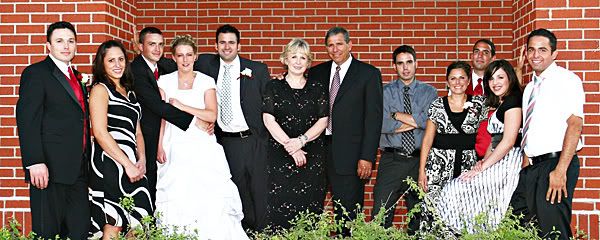Today I'd like to address the topic of wedding formals.
You've taken a lot of time and spent a lot of hours scouring over photographer's galleries and portfolios when hiring a wedding photographer. You've chosen your photographer for a reason. Perhaps it's their artistic images that captured you. Maybe it was their personality. Perhaps you really loved the albums they offered.
Now that you've signed your contract and sent in your deposit your photographer may ask you for a list of family members you'd like to have included in your wedding formal pictures.
I've had a lot of brides give me a variety of lists, some very minimal, because they want me to focus more on artistic pictures for the day. And some brides have given me a more extensive list, wanting to make sure they are photographed with each member of their day, which is fine with me, but takes a lot of time and also cuts down on the time I can spend doing more creative work for them. It all depends on what the bride and groom really want, when placing images in their wedding album.
There is one issue I'd like to address with future brides in particular, when considering on who to have photographed in your wedding formals. You and your groom are coming together to create a union.
Mark 10: 7-8 (KJV)
For this cause shall a man leave his father and mother, and cleave to his wife; And they twain shall be one flesh: so then they are no more twain, but one flesh.
This is a union between two families. Two families becoming one. You will now belong to his family, and your groom will belong to your family. There is no reason to have individual pictures of yourselves with your family members. There are several reasons why it is not necessary. First, it quite often ends up with redundant images and burned up time, which will make less time for more artistically inspired photography. It can also wear out the whole family having to wait around for their turn in the pictures. In the end it can end up being one long portrait session instead of a wedding session. Please consider having only one image with you and your family together without your bride and groom, and then one image with both of you with the entire family instead of individual pictures of you with each of your family members.

When deciding what images you really want in your album to look back on in the next 50 years, think about what is most important to you. When choosing your photographer, what images were you drawn to most? Are pictures of your family what you will hold most dear, or will you want more artistic images?
You make the call.
You've taken a lot of time and spent a lot of hours scouring over photographer's galleries and portfolios when hiring a wedding photographer. You've chosen your photographer for a reason. Perhaps it's their artistic images that captured you. Maybe it was their personality. Perhaps you really loved the albums they offered.
Now that you've signed your contract and sent in your deposit your photographer may ask you for a list of family members you'd like to have included in your wedding formal pictures.
I've had a lot of brides give me a variety of lists, some very minimal, because they want me to focus more on artistic pictures for the day. And some brides have given me a more extensive list, wanting to make sure they are photographed with each member of their day, which is fine with me, but takes a lot of time and also cuts down on the time I can spend doing more creative work for them. It all depends on what the bride and groom really want, when placing images in their wedding album.
There is one issue I'd like to address with future brides in particular, when considering on who to have photographed in your wedding formals. You and your groom are coming together to create a union.
Mark 10: 7-8 (KJV)
For this cause shall a man leave his father and mother, and cleave to his wife; And they twain shall be one flesh: so then they are no more twain, but one flesh.
This is a union between two families. Two families becoming one. You will now belong to his family, and your groom will belong to your family. There is no reason to have individual pictures of yourselves with your family members. There are several reasons why it is not necessary. First, it quite often ends up with redundant images and burned up time, which will make less time for more artistically inspired photography. It can also wear out the whole family having to wait around for their turn in the pictures. In the end it can end up being one long portrait session instead of a wedding session. Please consider having only one image with you and your family together without your bride and groom, and then one image with both of you with the entire family instead of individual pictures of you with each of your family members.

When deciding what images you really want in your album to look back on in the next 50 years, think about what is most important to you. When choosing your photographer, what images were you drawn to most? Are pictures of your family what you will hold most dear, or will you want more artistic images?
You make the call.
© 2009 Jennifer Klingensmith


